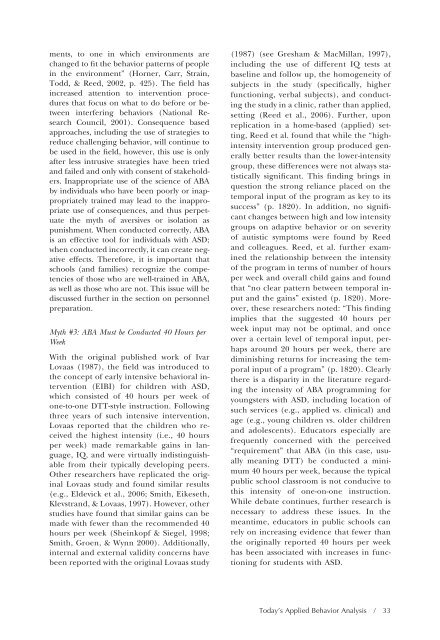Beyond Time Out and Table Time - Division on Autism and ...
Beyond Time Out and Table Time - Division on Autism and ...
Beyond Time Out and Table Time - Division on Autism and ...
You also want an ePaper? Increase the reach of your titles
YUMPU automatically turns print PDFs into web optimized ePapers that Google loves.
ments, to <strong>on</strong>e in which envir<strong>on</strong>ments are<br />
changed to fit the behavior patterns of people<br />
in the envir<strong>on</strong>ment” (Horner, Carr, Strain,<br />
Todd, & Reed, 2002, p. 425). The field has<br />
increased attenti<strong>on</strong> to interventi<strong>on</strong> procedures<br />
that focus <strong>on</strong> what to do before or between<br />
interfering behaviors (Nati<strong>on</strong>al Research<br />
Council, 2001). C<strong>on</strong>sequence based<br />
approaches, including the use of strategies to<br />
reduce challenging behavior, will c<strong>on</strong>tinue to<br />
be used in the field, however, this use is <strong>on</strong>ly<br />
after less intrusive strategies have been tried<br />
<str<strong>on</strong>g>and</str<strong>on</strong>g> failed <str<strong>on</strong>g>and</str<strong>on</strong>g> <strong>on</strong>ly with c<strong>on</strong>sent of stakeholders.<br />
Inappropriate use of the science of ABA<br />
by individuals who have been poorly or inappropriately<br />
trained may lead to the inappropriate<br />
use of c<strong>on</strong>sequences, <str<strong>on</strong>g>and</str<strong>on</strong>g> thus perpetuate<br />
the myth of aversives or isolati<strong>on</strong> as<br />
punishment. When c<strong>on</strong>ducted correctly, ABA<br />
is an effective tool for individuals with ASD;<br />
when c<strong>on</strong>ducted incorrectly, it can create negative<br />
effects. Therefore, it is important that<br />
schools (<str<strong>on</strong>g>and</str<strong>on</strong>g> families) recognize the competencies<br />
of those who are well-trained in ABA,<br />
as well as those who are not. This issue will be<br />
discussed further in the secti<strong>on</strong> <strong>on</strong> pers<strong>on</strong>nel<br />
preparati<strong>on</strong>.<br />
Myth #3: ABA Must be C<strong>on</strong>ducted 40 Hours per<br />
Week<br />
With the original published work of Ivar<br />
Lovaas (1987), the field was introduced to<br />
the c<strong>on</strong>cept of early intensive behavioral interventi<strong>on</strong><br />
(EIBI) for children with ASD,<br />
which c<strong>on</strong>sisted of 40 hours per week of<br />
<strong>on</strong>e-to-<strong>on</strong>e DTT-style instructi<strong>on</strong>. Following<br />
three years of such intensive interventi<strong>on</strong>,<br />
Lovaas reported that the children who received<br />
the highest intensity (i.e., 40 hours<br />
per week) made remarkable gains in language,<br />
IQ, <str<strong>on</strong>g>and</str<strong>on</strong>g> were virtually indistinguishable<br />
from their typically developing peers.<br />
Other researchers have replicated the original<br />
Lovaas study <str<strong>on</strong>g>and</str<strong>on</strong>g> found similar results<br />
(e.g., Eldevick et al., 2006; Smith, Eikeseth,<br />
Klevstr<str<strong>on</strong>g>and</str<strong>on</strong>g>, & Lovaas, 1997). However, other<br />
studies have found that similar gains can be<br />
made with fewer than the recommended 40<br />
hours per week (Sheinkopf & Siegel, 1998;<br />
Smith, Groen, & Wynn 2000). Additi<strong>on</strong>ally,<br />
internal <str<strong>on</strong>g>and</str<strong>on</strong>g> external validity c<strong>on</strong>cerns have<br />
been reported with the original Lovaas study<br />
(1987) (see Gresham & MacMillan, 1997),<br />
including the use of different IQ tests at<br />
baseline <str<strong>on</strong>g>and</str<strong>on</strong>g> follow up, the homogeneity of<br />
subjects in the study (specifically, higher<br />
functi<strong>on</strong>ing, verbal subjects), <str<strong>on</strong>g>and</str<strong>on</strong>g> c<strong>on</strong>ducting<br />
the study in a clinic, rather than applied,<br />
setting (Reed et al., 2006). Further, up<strong>on</strong><br />
replicati<strong>on</strong> in a home-based (applied) setting,<br />
Reed et al. found that while the “highintensity<br />
interventi<strong>on</strong> group produced generally<br />
better results than the lower-intensity<br />
group, these differences were not always statistically<br />
significant. This finding brings in<br />
questi<strong>on</strong> the str<strong>on</strong>g reliance placed <strong>on</strong> the<br />
temporal input of the program as key to its<br />
success” (p. 1820). In additi<strong>on</strong>, no significant<br />
changes between high <str<strong>on</strong>g>and</str<strong>on</strong>g> low intensity<br />
groups <strong>on</strong> adaptive behavior or <strong>on</strong> severity<br />
of autistic symptoms were found by Reed<br />
<str<strong>on</strong>g>and</str<strong>on</strong>g> colleagues. Reed, et al. further examined<br />
the relati<strong>on</strong>ship between the intensity<br />
of the program in terms of number of hours<br />
per week <str<strong>on</strong>g>and</str<strong>on</strong>g> overall child gains <str<strong>on</strong>g>and</str<strong>on</strong>g> found<br />
that “no clear pattern between temporal input<br />
<str<strong>on</strong>g>and</str<strong>on</strong>g> the gains” existed (p. 1820). Moreover,<br />
these researchers noted: “This finding<br />
implies that the suggested 40 hours per<br />
week input may not be optimal, <str<strong>on</strong>g>and</str<strong>on</strong>g> <strong>on</strong>ce<br />
over a certain level of temporal input, perhaps<br />
around 20 hours per week, there are<br />
diminishing returns for increasing the temporal<br />
input of a program” (p. 1820). Clearly<br />
there is a disparity in the literature regarding<br />
the intensity of ABA programming for<br />
youngsters with ASD, including locati<strong>on</strong> of<br />
such services (e.g., applied vs. clinical) <str<strong>on</strong>g>and</str<strong>on</strong>g><br />
age (e.g., young children vs. older children<br />
<str<strong>on</strong>g>and</str<strong>on</strong>g> adolescents). Educators especially are<br />
frequently c<strong>on</strong>cerned with the perceived<br />
“requirement” that ABA (in this case, usually<br />
meaning DTT) be c<strong>on</strong>ducted a minimum<br />
40 hours per week, because the typical<br />
public school classroom is not c<strong>on</strong>ducive to<br />
this intensity of <strong>on</strong>e-<strong>on</strong>-<strong>on</strong>e instructi<strong>on</strong>.<br />
While debate c<strong>on</strong>tinues, further research is<br />
necessary to address these issues. In the<br />
meantime, educators in public schools can<br />
rely <strong>on</strong> increasing evidence that fewer than<br />
the originally reported 40 hours per week<br />
has been associated with increases in functi<strong>on</strong>ing<br />
for students with ASD.<br />
Today’s Applied Behavior Analysis / 33
















